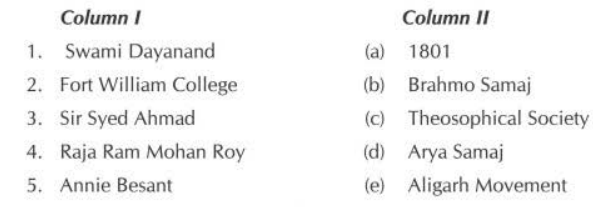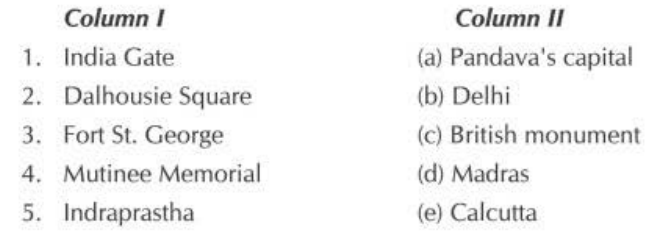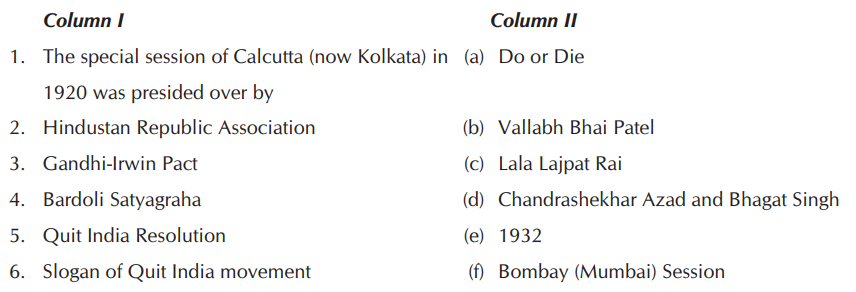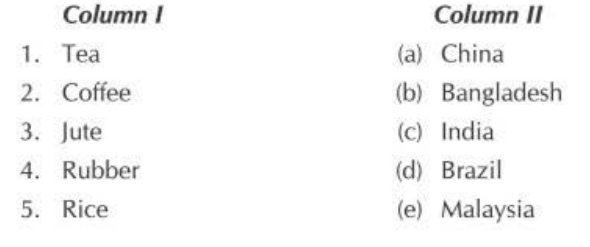Question bank
Chapter-1 Education and the British Rule
Q-1 Fill in the blanks:
(a) The Muslims remained backward because ____________
(b) The Theosophical Society was different from other reform movements because ________
(c) Regional languages developed at this time because ________
(d) Progress of science was hampered because of ________
(e) Swami Dayanand Saraswati founded the_________ in _________
(f) Swami Vivekananda was a disciple of __________
(g) Temples were the focus of reforms in ________India.
(h) __________won the Nobel Prize for Literature in 1913.
(i) Reforms were first started in Bengal because ___________
Q-2 Match the following:

Q-3 Write True or False for each statement:
Q-4 Answer the following questions in short:
Q-5 Answer the following questions in long
Multiple Choice Questions
Q-1 Who was the founder of Brahmo Samaj?
(i)
Keshav Chandra Sen
(ii)
Bankim Chandra Chatterjee
(iii)
Dwarka Nath Tagore
(iv)
Raja Ram Mohan Roy
Q-2 The Aligarh Muslim University was founded by
(i)
Gopal Krishna Gokhale
(ii)
Raja Ram Mohan Roy
(iii)
Sir Syed Ahmed Khan
(iv)
Swami Dayanand
Q-3 Who was the most important socio-religious reformer of the Muslims in the 19th century?
(i)
Sir Syed Ahmad Khan
(ii)
Muhammad Iqbal
(iii)
Maqsud Ali
(iv)
Mohd Ali Jinnah
Chapter-2 Women and Reform Movements in India
Q-1 Fill in the blanks:
3. ................... abolished the sati practice by law.
5. The Widow Remarriage Act was passed in .................... .
2. The first women's uplift movement in Maharashtra was led by .................... .
Q-2 Establish a link between Column A and Column B:

Q-3 State if the sentences are True/False:
Q-4 Answer the following questions in short:
6. Who was the most prominent Muslim reformer? What is his main contribution?
Q-5 Answer the following questions in long:
2. Describe the contribution of Bengal to the upliftment of women.
3. Describe the contribution of Maharashtra in the women's uplift.
4. Evaluate the status of women during the British rule.
5. Why was the need for social reforms for women felt?
6. Evaluate the coming of the British in India as a boost to the works of the Indian reformers.
7. What was the impact of literature on social reforms ?
8. What was the impact of various reforms in the sphere of legislation?
Multiple Choice Questions
Q-1 'Lokhitavadi' title was given to :
(i)
Keshab Chandra Sen
(ii)
Gopal Hari Deshmukh
(iii)
Govind Ranade
Q-2 The custom of sari was banned by:
(i)
Raja Ram Mohan Roy
(ii)
Lord William Bentinck
(iii)
Lord Macaulay
Q-3 The Widow Remarriage Act was brought about by the untiring efforts of:
(i)
Raja Ram Mohan Roy
(ii)
lshwar Chandra Vidhyasagar
(iii)
Keshab Chandra Sen
Q-4 lshwar Chandra Vidyasagar championed female education and led the campaign for-
(i)
Remarriage
(ii)
Child education
(iii)
None of these
(iv)
Widow remarriage
Q-5 Reform movements showed the guiding light for ................. to be enacted.
(i)
Laws
(ii)
Rules
(iii)
Traditions
(iv)
All of these
Chapter-3 Colonialism and Urban Change
Q-1 Fill in the blanks:
Q-2 Match the columns:

Q-3 Write True or False:
1. The British introduced the railways in India in 1858.
3. Pondicherry was established by the French.
Q-4 Answer the following questions in short:
4. Name the city with the highest population of India in 1800s?
5. Why did Calcutta gain importance under the British?
6. How did acquisition of Bombay benefit the British in India?
7. Name some places in Madras which deserve special mention.
8. Who set up a separate Public Works Department during the British rule?
9. How did the introduction of railways help urbanization?
Q-5 Answer the following questions in long:
Multiple Choice Questions
Q-1 Railways were introduced in India in
(i)
1857
(ii)
1858
(iii)
1853
(iv)
1852
Q-2 Calcuta was the capital of India till
(i)
1800
(ii)
1872
(iii)
1911
(iv)
1902
Q-3 Which city was built by a Mughal Emperor?
(i)
Firozabad
(ii)
Siri
(iii)
Shahjahanabad
(iv)
lndraprastha
Q-4 Waltair emerged as a
(i)
Administrative town
(ii)
Commercial town
(iii)
Port town
(iv)
Railway town
Chapter-4 Reforming the Caste System
Q-1
Match the Columns:

Q-2 Fill in the blanks:
1. The caste system was the main cause of .................... .
3. ................... founded the Satya Shodhak Samaj.
4. ................... did his work in Kerala.
Q-3 Write True or False against each statement:
7. Jyotirao, along with his followers, formed the Shodhak Samaj.
Q-4 Answer the following questions in brief:
Q-5 Answer the following questions in long:
3. Evaluate the work of Dr B.R. Ambedkar for the uplift of the depressed classes.
4. Who gave the term Harijan? Explain his reason of coining this term.
5. What did Gandhi ji do for the cause of the depressed classes?
6. Define caste system along with its negative aspects.
Q-6 Write short notes on the following:
Multiple Choice Questions
Q-1 ___________ fought to end caste discrimination in Maharashtra.
(i)
Kabir
(ii)
Jyotirao Govindrao Phule
(iii)
Mughal
(iv)
Shri Nanak Guru
Q-2 All India Harijan Sevak Sangh was founded by
(i)
Mahatma Gandhi
(ii)
Dr B.R. Ambedkar
(iii)
None of these
(iv)
Shri Nanak Guru
Q-3 ..................... believe that there is no place for the caste system in Hinduism.
(i)
Swami Vivekananda
(ii)
Swami Ramananda
(iii)
Jyotiba Phule
(iv)
None of these
Q-4 A threefold division of society into priests, warriors and commoners was a part of the .............. heritage.
(i)
British
(ii)
Mughal
(iii)
Turk
(iv)
Aryan
Chapter-5 Changes in the Arts : Literature, Painting and Architecture
Q-1 Fill in the blanks:
1. Geetanjali was written by ________
2. New literary forms like centuries__________. and __________became popular in the 19th and 20th.
4. Prince of Wales Museum is situated in ___________
5. The Victoria Terminus is also known as _________
Q-2 True or False:
2. Sharat Chandra Chatterjee was a Bengali writer
Q-3 Answer the following questions in short:
1. Mention the famous civic monuments of the British period in Mumbai.
Q-4
Answer the following questions in detail:
Q-5
Match the Columns:

Multiple Choice Questions
Q-1 Rabindranath Tagore won Nobel Prize for his
(i)
Geetanjali
(ii)
Gora
(iii)
Galpa Guchcha
(iv)
Chare Baire
Q-2 'Rangbhoomi' is a novel written by
(i)
Bankim Chandra Chatterjee
(ii)
Munshi Prem Chand
(iii)
Vibhuti Bhushan
(iv)
Bhartendu Harish Chandra
Q-3 Abanindranath Tagore is known for his
(i)
Paintings
(ii)
Poetry
(iii)
Sculpture
(iv)
Music
Q-4 The Umaid Bhavan in Rajasthan is at
(i)
Gwalior
(ii)
Jodhpur
(iii)
Jaipur
(iv)
Bikaner
Chapter-6 Rise of Indian Nationalism
Q-1 Fill in the blanks:
1. Exploitation of India by the British was direct and harsh before 1857; after 1857 it became __________ and ____________
2. The ________rebellion was an armed rebel lion of the Sikhs against the British policy of divide and rule.
3. The English language acted as a ________ language among the educated Indians.
4. Western scholars like and researched the Indian past ___________ and rediscovered its rich heritage.
5. 'Vande Mataram ' was written by ___________
6. The Indian National Congress was established in the year and its first __________ session was held in ______
7. The Moderates spread___________ among the people.
8. Modern Indian nationalism arose to meet the challenges of __________
9. The most important leaders of the Moderates were __________ and _________
Q-2 Match the following columns:

Q-3 State whether the following are true or false:
Q-4 Answer the following questions in short:
Q-5 Answer the following questions in long:
4. What methods did the revolutionaries adopt to liberate India from British rule? What were the weaknesses of their movement?
Chapter-7 Struggle for Indian Freedom 1919-1947
Q-1 Fill in the blanks:
(5) ................. (khadi/charkha) became the symbol of freedom.
(1) Mahatma Gandhi dominated the Indian politics from 1919 to ..................... (1975/1947)
(2) Gandhiji used Satyagraha and ................... (ahimsa/violence) against the British.
(3) The Montague-Chelmsford Reform was also cal led the Government of ................... (India/Britain) Act of 1919.
(4) General ................... (Dyer/Montague) ordered fire at the crowd in Jallianwala Bagh on April 13,1919.
Q-2 Match the Columns:

Q-3 Say if the sentences are True/False:
1. The Government of India Act of 1919 is also known as the Minto reform
Q-4 Answer the following questions in brief:
2. Who were the Swarajists ? What was their purpose?
3. When did Gandhiji enter the National Movement?
4. When and where was the demand for Poorna Swaraj raised?
5. Why was the Cabinet Mission called so ? Who were its members?
Q-5 Answer the following questions in detail:
Multiple Choice Questions
Q-1 Where did the Gandhiji break the Salt law?
(i)
Sabarmati Ashram
(ii)
Bardoli
(iii)
Dandi
(iv)
Kheda
Q-2 Where did Gandhiji first used Satyagraha?
(i)
Kheda
(ii)
Ahmedabad
(iii)
South Africa
(iv)
Champaran
Q-3 Who organised the Indian National Army?
(i)
Subhash Chandra Bose
(ii)
Captain Mohan Singh
(iii)
None of these
(iv)
Ras Bihar Bose
Q-4 The first Governor General of India was
(i)
Lord Mountbatten
(ii)
Chakravarti Rajgopalachari
(iii)
Dr. Rajendra Prasad
(iv)
None of these
Chapter-8 Agriculture
Q-1 Fill in the blanks
3. Tea and coffee are included in ____________crops
4.________ agriculture is also known as slash and burn agriculture.
5. Jowar, Bajra and ragi are the important _________
Q-2 State 'True' or 'False
3. Rearing of silkworm for the production of silk fibre is known as sericulture
Q-3 Match the Columns:

Q-4 Give answer in short:
12. Which crop is called "Golden Fibre"?
Q-5 Give answer in detail:
1. Differentiate between subsistence farming and commercial farming
2. What do you mean by a farm system?
Multiple Choice Questions
Q-1 Which of the following activity is considered as primary activity?
(i)
Communication
(ii)
Banking
(iii)
Agriculture
(iv)
Transport
Q-2 Which of the following crops grown in subsistence agriculture?
(i)
Rubber
(ii)
Potato
(iii)
Tea
(iv)
Sugarcane
Q-3 Which of the following factor plays an important role in the development of agriculture?
(i)
Topography
(ii)
Climate
(iii)
Soil
(iv)
All the above
Q-4 Which is the leading producer of coffee in the world?
(i)
Brazil
(ii)
South Africa
(iii)
China
(iv)
India
Q-5 Which of the following is a horticulture crop?
(i)
Mango
(ii)
Onion
(iii)
AlI the above
(iv)
Cabbage
Chapter-9 Manufacturing Industries
Q-1 Fill in the blanks:
3. Silicon Valley is famous for ________
Q-2 State if the sentences are 'True' or 'False'
Q-3 Match the following:

Q-4 Answer the following questions in short:
Q-5 Answer the following questions in detail:
Multiple Choice Questions
Q-1 Which of the following is an example of industries?
(i)
Coal mining
(ii)
Manufacturing of leather goods
(iii)
All the above
(iv)
Weaving and spinning
Q-2 Which of the following industries is an example of agro-based industry?
(i)
Automobile
(ii)
Cotton textile
(iii)
Watch making
(iv)
Aluminum smelting
Q-3 Which of the following industry comes under private sector?
(i)
Hero-Honda
(ii)
Steel Authority of India Ltd.
(iii)
Amul
(iv)
Sugar Mill
Q-4 Where was the first successful modern textile mill set up?
(i)
Kolkata
(ii)
Chennai
(iii)
Mumbai
(iv)
Kanpur
Q-5 When was the Tata Iron and Steel Company set up?
(i)
1907
(ii)
1909
(iii)
1905
(iv)
1908
Chapter-10 Human Resources
Q-1 Fill in the blanks:
2. The USA, Australia, Canada have gained population due to _________
3. The average population density of the world is __________persons/ km Square .
Q-2 State if the sentences are 'True' or 'False'
Q-3 Answer the following question in short:
6. Name the two types of migration.
7. What do you mean by population composition ?
8. Define sex ratio.
9. What do you mean by literacy?
10. What do you understand by optimum population?
11. What is the impact of age group on population?
12. What do you mean by population change?
Q-4 Answer the following question in detail:
1. Discuss the factors responsible for distribution of population in the world.
2. What is the importance of population pyramid? Justify your answer with suitable examples.
3. What are the future prospects for the distribution of population in the world?
4. Discuss the population problems related with developing countries.
5. What problems are faced by in developed countries in respect of population?
6. Discuss the pattern of population growth in the world.
7. Define the following demographic terms. i. Birth rate ii. Death rate iii. Migration
Q-5 Match the following columns:

Multiple Choice Questions
Q-1 Which of the fol lowing countries is the second largest populated country o f the world?
(i)
India
(ii)
China
(iii)
Japan
(iv)
Pakistan
Q-2 Western and Central Europe is densely populated due to the availability of
(i)
water
(ii)
soil
(iii)
none of the above
(iv)
minerals
Q-3 Thar desert is sparsely populated due to
(i)
climate
(ii)
sand
(iii)
mountains
(iv)
thorny bushes
Q-4 Which of the following is the major cause of population growth?
(i)
birth rate
(ii)
death rate
(iii)
migration
(iv)
natural growth rate
Q-5 Which of the following country is the example of population change due to emigration
(i)
Sudan(ii)
USA(iii)
Canada(iv)
AustraliaChapter-11 The Judiciary
Q-1 Fill in the blanks:
2. The judges of the Supreme Court retire at the age of ________
3. Judges of the High Court and the Supreme Court are appointed by the _______
4. Popular courts which decides cases at a much quicker speed are called _______
5. The courts at the district levels are known as _______
Q-2 State True or False
Q-3 Answer the following questions in short:
Q-4 Answer the following questions in detail:
Multiple Choice Questions
Q-1 The High Court is the highest court of Justice at the level.
(i)
State(ii)
District
Q-2 Matters relating to violation of fundamental rights can be dealt with by ______
(i)
High Court
(ii)
the GovernorQ-3 The Chief Justice of a H igh Court is appointed by
(i)
The President
(ii)
the Governor
Q-4 The_________ is the highest court of appeal in India
(i)
Supreme Court(ii)
High CourtChapter-12 Elements of Judicial Structure
Q-1 Fill in the blanks
Q-2 Say if the following sentences are True or False:
Q-3 Match the following columns

Q-4 Answer the following in detail:
3. What is FIR?
Q-5 Answer the following questions:
Chapter-13 Social Justice and the Marginalised
Q-1 Fill in the blanks:
2. Weaker sections of the society who lives in tribal areas are called ________
3. The population of SCs according to 2001 census is ______
4. About 15% of the jobs under the government are reserved for the _______
Q-2 State True or False:
1. The scheduled castes population in concentrated in Uttar Pradesh only.
2. 27% of the seats under the government has been reseNed for the scheduled tribes.
3. Articles 29 and 30 deals with safeguarding the rights of the minorities
4. According to 2001 census the percentage of scheduled tribes was 84.3%.
5. The Constitution of India makes untouchability an offence
Q-3 Match the following:

Q-4 Answer the following questions in short:
Q-5 Answer the following question in detail:
Chapter-14 Economic Presence of the Government
Q-1 Fill in the blanks:
Q-2 Match the following:

Q-3 State if the sentences are True or False:
4. Planning Commission was formed after the __________.